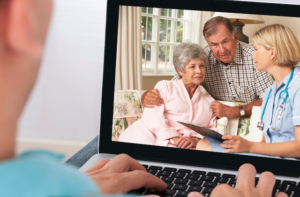Getting Onboard the Remote Care Monitoring Train
 If you have not done research to find the right Remote Care Monitoring for your agency, now is the time.
If you have not done research to find the right Remote Care Monitoring for your agency, now is the time.
Since 2020 and the onset of the pandemic, the healthcare industry has been forced to use technology as a ‘partner’ in evaluating and treating patients in real time. Physicians were quick to adopt Telehealth as a means of meeting the needs of their patients virtually.
Telehealth is a broad term referring to the methodology and technology enabling many types of health care. In the homecare setting, ‘remote care monitoring’ uses this ‘telehealth’ technology, but is a much more acceptable choice in maintaining a more personal connection with patients.
The availability of remote care patient allows the clinician to use technology to facilitate interaction between the clinician and the patient visualize the patient. The clinician can evaluate the patient in real time and assess immediate needs relative to social determinants. Remote care monitoring just might the next “best practice” to the road to improved patient outcomes.
Recent research indicates digital care tools actually help homecare agencies expand the access to care, improve patient engagement and assist with positive patient outcomes that will be critical as we move into the world of Value Based Purchasing.
The University of Michigan recently conducted a “National Poll on Healthy Aging”. The results were very interesting and should be considered as you do your own research in assessing different remote care/telehealth monitoring systems. Consider the following findings:
- Approximately 14% of adults responding indicated that their healthcare provider (s) (physicians and homecare) offered telehealth/remote care monitoring. This is a very low number, but is not surprising since so many agencies still has not embraced the idea of remote visits and Medicare is still not reimbursing for such.
- For those who had at least one telehealth visit over the past year, 46% expressed greater satisfaction with remote monitoring than actually visiting a physician office.
- 50% of those who had no experience with remote monitoring indicated an acute interest and
- Would use telehealth for an unexpected illness. Fewer indicated interest in using remote visits to discuss a new health problem or a sensitive health issue or mental health issue.
With a growing number of healthcare providers having an interest in some type of remote monitoring, now is the time to collect data from your own patients and consider a choice in remote care providers. More and more aging adults are using devices compatible with remote monitoring and telehealth. Connected Home Living would be happy to discuss various options for you organization.
